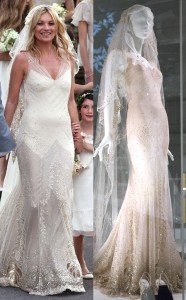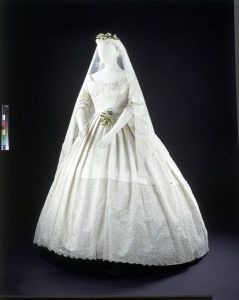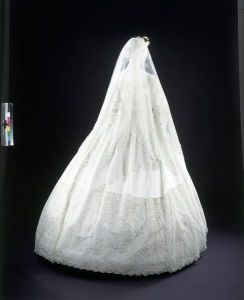Have you visited Wedding Dresses 1775-2014 in V&A Museum in London? If you haven’t yet, you lace lovers it is a big chance to get an up-close-and-personal look at the fascinating Honiton laces from 18th century!
It won’t be wrong if we call Wedding Dresses 1775-2014 as an informative bridal gown exhibition. You could discover the white became popular in 1840s after the marriage of Queen Victoria and Prince Albert on 10 February 1840. Or you could learn that in 18th century the brides wore colourful and flowered wedding dress and they could wear it more than once.
Also, thanks to V&A Blog you could explore more about Kate Moss’ wedding dress like its designer is John Galliano and its total of 390,000 sequins and 2800 pearls.

Here’s my favourite, bespoke wedding dress of Eliza Penelope Clay who married with and Joseph Bright, at St James’s Church, Piccadilly, London, on 16 February 1865.

The look consists of three traditional main pieces, wedding dress, veil and headdress. The colour, ivory-white-cream, was popular in 1800s and was implied purity, cleanliness and elegance. Supporting the skirt by a cage crinoline, protruded out more from behind in contrast to 1850s’ bell shaped look,the silhouette was succeed to getting a wide look.
Queen Victoria wore a very simple satin dress by combining English lace in her wedding ceremony. Besides setting a royal trend, she also promoted English lace and British manufactures and also, influenced the other brides’ wedding dress’ fabrics decisions.
We still don’t know the designer of Eliza Penelope Clay’s wedding dress. But the designer maintained an Queen Victoria influence in his artwork in terms of choosing English lace. This bespoke wedding dress crafted from silk-satin and trimmed with Honiton applique lace, machine net and bobbin lace and hand-sewn. The feminine-cut to expose shoulder neck set out the elegance by framed Honiton appliqué lace. The sides of the skirt also designed by using the same lace to balance the look.

In accessories, skilfully designed Honiton applique laced veil allows us to see the one of the original look of Honiton patterns, inspired by flowers. Besides, Honiton appliqué laced veil attached to the bride’s flowered tiara, another flowered detail on the belt blinking the eyes to the spring.
You lace lovers, if you would like to go deeper into Honiton lace like me, I could say that Honiton and its heritage is a must to know as a brand and a manufacturer! Hurry up, you have just 4 days left to see it!
Lastly, I came across this amazing museum called Allhallows Museum/Honiton Museum, located in Devon, which has the Honiton lace examples of 16th to early 20th century! I am dying to visit there!
Lace it up!
HS
